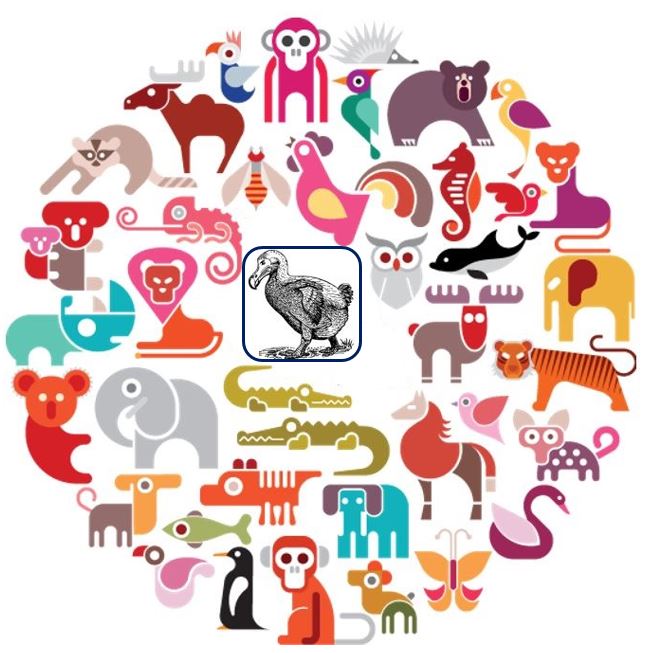Climate change speed is occurring too fast for many animals and plants – they cannot adapt quickly enough and are in serious danger of eventually failing completely, i.e. going extinct, say two scientists from the University of Arizona at Tucson. Some species will fare better than others, but overall it is going to be a huge struggle for a sizable proportion of them.
In this latest study, Tereza Jezkova and John Wiens, who both work at the University of Arizona’s Department of Ecology and Evolutionary Biology, explained in the journal Proceedings of the Royal Society B: Biological Sciences (citation below) that they studied over 260 animals and plants.
They found that the adaptability of several of these species to changes in temperature and rainfall will be significantly outpaced by future climate change speed, also known as global warming.
 The snow leopard or ounce (Panthera uncia syn. Uncia uncia) lives in the mountain ranges of Central and South Asia. It is listed as ‘Endangered’. Many of them live in hapitats that are completely surrounded by human urban areas. It’s only option is to move further and further up the hill. But a mountain is only so high! (Image: snowleopard.org)
The snow leopard or ounce (Panthera uncia syn. Uncia uncia) lives in the mountain ranges of Central and South Asia. It is listed as ‘Endangered’. Many of them live in hapitats that are completely surrounded by human urban areas. It’s only option is to move further and further up the hill. But a mountain is only so high! (Image: snowleopard.org)
Technically, global warming only refers to rising global temperatures, but today it is commonly used interchangeably with climate change, which also includes rainfall patterns and incidences of extreme weather events such as hurricanes, droughts, floods, tornadoes, etc.
Of all the species on Earth, plants, reptiles and amphibians are probably going to suffer the most, the authors wrote.
Climate change speed to hit tropics worst
Animals and plants in temperate zones will probably fare better than those in tropical environments.
In an Abstract that describes the main paper in the journal, the authors wrote:
“Rates were broadly similar between plants and animals, but especially rapid in some arthropods, birds and mammals. Rates for temperature variables were lower at lower latitudes, further suggesting that tropical species may be especially vulnerable to climate change.”
While some animals will be able to physically move geographically to find more habitable environments as temperatures go up, others live in remote or isolate areas where they will be unable to migrate, such as islands, mountains or nature reserves.
 Over the next 50, 100 or 200 years, how many species will go the same way as the Dodo? The Dodo (Raphus cucullatus) was flightless bird that was endemic to the island of Mauritius. It was entirely fearless to humans – a trait that cost the species its whole existence. Animals that humans brought to the island, like dogs, cats and crab-eating macaques competed for food with the Dodo and plundered its nests. The last Dodo to be seen by a human was about two hundred years ago. (Image: adapted from Mazama Biology)
Over the next 50, 100 or 200 years, how many species will go the same way as the Dodo? The Dodo (Raphus cucullatus) was flightless bird that was endemic to the island of Mauritius. It was entirely fearless to humans – a trait that cost the species its whole existence. Animals that humans brought to the island, like dogs, cats and crab-eating macaques competed for food with the Dodo and plundered its nests. The last Dodo to be seen by a human was about two hundred years ago. (Image: adapted from Mazama Biology)
An amphibian that lives in a nature reserve surrounded by urban areas is stuck there. If temperatures rise, it will have to do the best it can to survive – but remaining there – it cannot go anywhere else.
The researchers analyzed how rapidly species had changed their climatic niches – habitats where they are able to survive – over time, and compared these rates with climate change speed.
They analyzed reptiles, mammals, birds, amphibians and insects – a total of 266 different populations.
Climate change speed outpaces climatic niche change
They were moving into different climatic niches at a much slower rate than a computer model’s climate change speed. Climate change speed outpaced climatic niche changes by a factor of 200,000.
They also found that the absolute niche divergence among animal and plant populations was typically lower than the scale of projected change over the c. 55 years for relevant variables.
Their findings suggest that the amount of change required to prevail in most cases will be too great, even if these shift changes are done instantaneously.
The authors said:
“Overall, our results show that rates of climatic niche change among populations of plants and animals are dramatically slower than projected rates of future climate change.”
Reptiles and amphibians – animals that cannot regulate their body temperatures – will find it much harder to survive, compared to warm-blooded mammals and birds, they explained.
Some species may be able to move north/south or further up the mountain, but others will have to stay where they are.
In an interview with BBC News, Dr. Wiens said:
“It’s a double jeopardy of climate change and habitat destruction.”
 The study authors: Tereza Jezkova explores distributions of climatic niches used by the montane insect species of the Arizona Sky Islands. John J. Wiens is interested in the Phylogenetic approaches to evolution and ecology Systematic theory and methodology, ecology of reptiles & amphibians, and Phylogeny evolution. (Images: T. Jeskova. 2. J. J. Wiens)
The study authors: Tereza Jezkova explores distributions of climatic niches used by the montane insect species of the Arizona Sky Islands. John J. Wiens is interested in the Phylogenetic approaches to evolution and ecology Systematic theory and methodology, ecology of reptiles & amphibians, and Phylogeny evolution. (Images: T. Jeskova. 2. J. J. Wiens)
Earth facing mass extinction
Our planet is hurtling towards its first mass extinction of animals since the dinosaurs’ demise sixty-five million years ago, a Living Planet report warned last month.
By the end of this decade, populations of reptiles, fish, birds, mammals and other vertebrates are predicted to have declined by over two-thirds since fifty years ago.
Life forms on Earth are going extinct 100 times faster than normal, i.e. if humans were not around. This frightening pace is faster than some of the mass extinctions in our planet’s history.
This is the first time an animal species – humankind – is the cause of a mass extinction. For example, the dinosaurs probably went extinct because of a killer asteroid that crashed near the coast of what is today Mexico (Yucatan peninsula) 65 million years ago.
The authors of the report wrote:
“The Living Planet Index reveals that global populations of fish, birds, mammals, amphibians and reptiles declined by 58 per cent between 1970 and 2012.”
“We could witness a two-thirds decline in the half-century from 1970 to 2020 – unless we act now to reform our food and energy systems and meet global commitments on addressing climate change, protecting biodiversity and supporting sustainable development.”
Citation: “Rates of change in climatic niches in plant and animal populations are much slower than projected climate change,” Tereza Jezkova, John J. Wiens. Proceedings of the Royal Society B (Biological Sciences), 23rd November, 2016. DOI: 10.1098/rspb.2016.2104.
Video – Mass extinction closer than we think
This RT video, uploaded in April 2016, talks about two scientific papers that warn that climate change speed is occurring at a much faster rate than many of us realize, and in a more dangerous direction.
